SECTION A (25 marks)
Answer all the questions in this section in the spaces provided.
- State the reason why when a ray of light strikes a mirror at 900, the reflected ray travels along the same path as the incident ray. (1 mark)
- Explain why the image formed in a pin hole camera gets blurred when the hole is enlarged. (2 marks)
- State the reason why the magnetic field strength of a magnet is greatest at the poles. (1 mark)
- Figure 1 shows a cell of e.m.f. 2 V connected in series with a resistor R and a switch S. Voltmeter V1 and V2 are connected the cell and the resistor respectively.
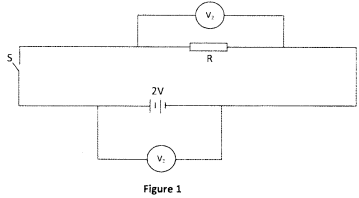
- State the reading of V1 with S open. (1 mark)
- With S closed, V1 reads 1.6 V. State the reading of V2. (1 mark)
- Figure 2 shows the image of an object formed by reflection in a converging mirror. C is the centre of curvature of the mirror.
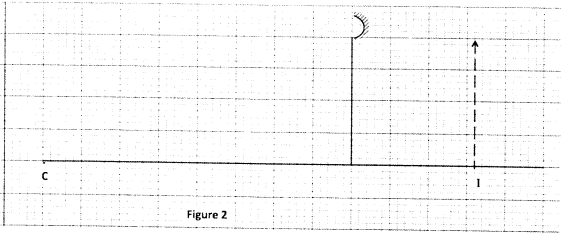
Complete the diagram to show:- How incident rays are reflected to show the image ; (2 marks)
- The object position. (1 mark)
- Figure 3 shows a ray of light passing into a glass prism ABC.
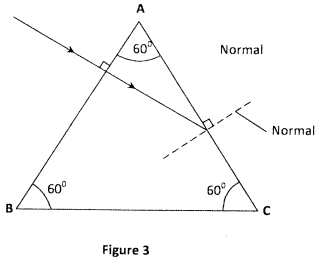
Sketch the path of the ray as it travels from face AC. (critical angle for glass is 420) (2 marks) - The equation below represents a nuclear reaction in which two deuterium nuclei fuse to form Helium and X.

- Determine the values of a and b. (1 mark)
- Identify X. (1 mark)
- Figure 4 shows a simple transformer connected to a 12 V a.c source and an a.c voltmeter.
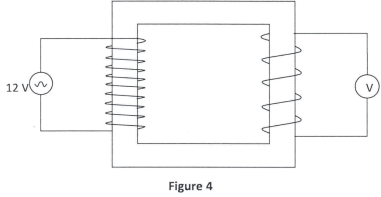
By counting the number of turns in each coil, determine the reading on the voltmeter. (3 marks) - In domestic wiring, two systems lamps in the lighting circuit are required to be in parallel and not in series.
State two reasons for this requirement. (2 marks) - Figure 5 shows a narrow beam of x-rays passing between two metal plates in air. The plates are connected in series with a switch, a cell and a milliameter.
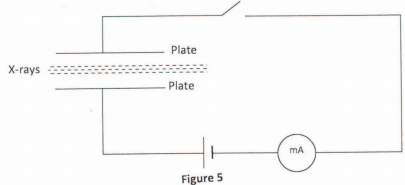
It is observed that when the switch is closed a current flows in the milliameter. Explain this observation. (2 marks) - Explain the fact that radiant heat from the sun penetrates a glass sheet while radiant heat from burning wood is cut off by the glass sheet. (2marks)
- A photon of ultraviolet light having energy E falls on a photoemissive surface whose work function is T. Write an equation for the maximum kinetic energy of the resulting photoelectron in terms of E and T. (1 mark)
- When a germanium crystal is doped with arsenic, it becomes an N-type semiconductor. Explain how this change occurs. (2 marks)
(Number of electrons in the outermost shell for germanium = 4, Arsenic = 5)
SECTION B (55 marks)
Answer all questions in this section.
- Figure 6 shows two convex lenses A and B used to produce a magnified virtual image of an object.
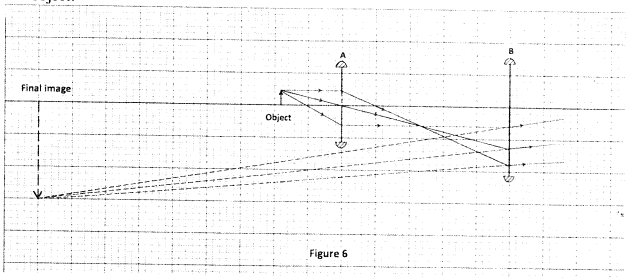
- Determine the focal length of lens A. (Take 1 unit to represent 10cm)
State the function of: -
- Lens A (1 mark)
- Lens B (1mark)
- State how the functions in (b) are achieved by:
- Lens A (1 mark)
- Lens B (1 mark)
- Determine the magnification produced by;
- Lens A (2 marks)
- The whole system. (2 marks)
- Determine the focal length of lens A. (Take 1 unit to represent 10cm)
-
- Explain how a positively charged electroscope get discharged when the cap is touched with a finger. (2 marks)
- Figure 7 shows capacitors A and B connected in series with a battery of e.m.f 4 V.
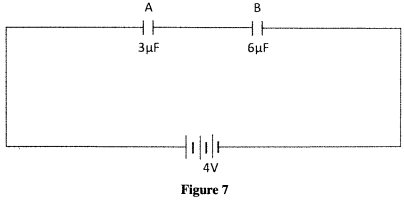
Determine:- The effective capacitance of the circuit. (3 marks)
- The quality of charge in capacitor A. (3 marks)
- The quantity of charge in capacitor B. (1 mark)
- Figure 8 shows an isolated negative point charge Q
.
On the figure, sketch the electric field pattern around the charge. (2 marks)
-
- Two points A and B have a potential difference of V volts. Q coulombs of charge flow between A and B for t seconds. Determine:
- The electrical energy transformed between the two points in terms of Q. (1 mark)
- The power transformed in terms of Q and t. (1 mark)
- Show that the power transformed is given by P = IV. (2 marks)
- The lighting circuit in a house has 20 lamp each rated 60 W, 240 V. Determine whether a fuse rated 4 A can be used in the circuit when all the lamps are put on. (4 marks)
- Two points A and B have a potential difference of V volts. Q coulombs of charge flow between A and B for t seconds. Determine:
-
- Figure 9 shows a cathode ray tube in which a beam of electrons is cast on the screen.
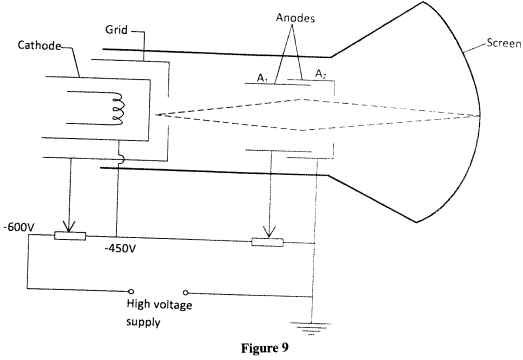
- State how the electrons are produced in the tube. (1 mark)
- State how the electron beam is detected. (1 mark)
- State a reason for having a variable potential difference (p.d) at the:
- grid; (1 mark)
- anodes. (1 mark)
- Figure 10 shows the waveform of a signal applied at the y-plates of an oscilloscope whose time-base is switched to the scale of 2 milliseconds per centimeter.
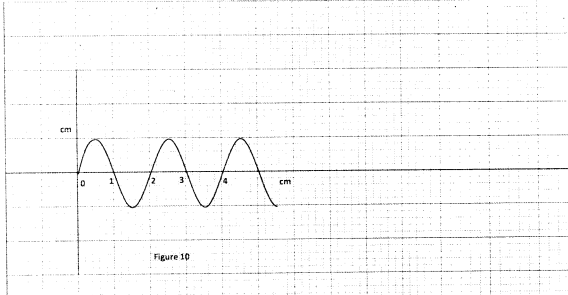
Determine:- The period of the signal. (2 marks)
- The frequency of the signal. (3 marks)
- Figure 9 shows a cathode ray tube in which a beam of electrons is cast on the screen.
-
- Figure 11 shows plane light waves in air incident on a convex lens whose principal focus is F, the waves moves past point G.
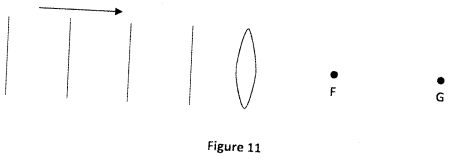
Complete the diagram to show the pattern of the emergent waves between the lens and point G. (2 marks) - Figure 12 shows crests of circular water waves spreading from two points A and B due to a vibrator. C and D are points on the surface of the water.
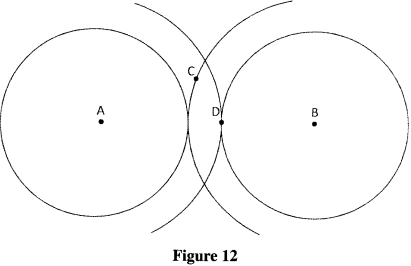
Given that the amplitude of each wave is 5 cm, state with a reason the amplitudes at point:- C; (2 marks)
- D. (2 marks)
- Figure 13 shows a standing wave formed when a string of length 1.5 m stretched between two supports is plucked in the middle.
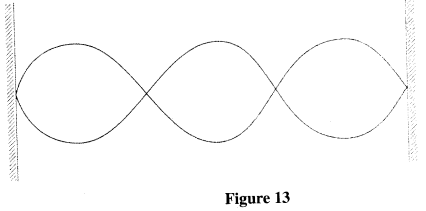
- Explain how the standing wave is formed. (3 marks)
- Determine the wavelength of the standing wave. (1 mark)
- Figure 11 shows plane light waves in air incident on a convex lens whose principal focus is F, the waves moves past point G.
-
- Figure 14 shows an E shaped steel block being magnetized by a current through two coils in a series.
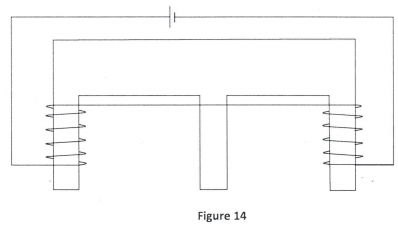
On the figure indicate:- The north and south poles of the resulting magnets. (1 mark)
- The complete magnetic field pattern between the poles. (1 mark)
- Figure 15 shows the permanent magnet made in part (a) above.
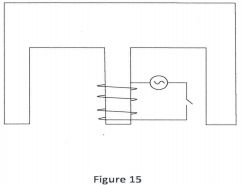
A coil would loosely on the middle limb is connected in series with a low voltage a.c. and a switch. State and explain the observation made on the coil when the switch is closed. (2 marks) - In a simple cell, the zinc plate gets negatively charged and the copper plate gets positively charged.
- Name the electrolyte in the cell. (1 mark)
- Explain how:
- Zinc gets negatively charged. (1 mark)
- Copper gets positively charged. (1 mark)
- State what constitutes the current when a wire used to connect the zinc plate and copper plate externally. (1 mark)
- Figure 14 shows an E shaped steel block being magnetized by a current through two coils in a series.

MARKING SCHEME
SECTION A
- angle of incidence = angle of reflection = 0 (1 mark)
- larger hole acts as many small holes (1 mark)
` many overlapping images of same object (1 mark) - Within the magnet, N and S poles of the dipoles cancel out but at the end of the poles they don’t. (1 mark)
-
- 2V (1 mark)
- 1.6V (1 mark)

Object at the intersection of incident ray; (1 mark)
Incident rays; (2 marks)- Ray totally reflected by face AC (1 mark)
i = 60c hence r = 60c (1 mark) - a= 1 and b = 0 (1 mark)
x = neutron (1 mark) - Ns = Vs(1 mark)
Np Vp
Vs = 6V (1 mark) - Each lamp on full voltage (1 mark)
Failure of one lamp does not affect the others (1 mark) - X rays ionise air molecules between plates (1 mark)
Ions move to plates of opposite sign (1 mark) - Sun being hotter produces short wavelength infrared waves which penetrate glass;
burning wood produces long wavelength infrared waves which do not penetrate glass.(1 mark) - K=E-T (1 mark)
- Arsenic shares 4 of its 5 electrons with germanium. (1 mark) the extra electron is free for conduction. (1 mark)
SECTION B
-
- fA = 10cm(1 mark)
-
- to produce a magnified real image (1 mark)
- to produce a magnified virtual image of the 1st image. (1 mark)
-
- move A so that the object is slightly outside fA(1 mark)
- move B so that the real image is within fB. (1 mark)
-
- m =24
16
= 3
2 (2 marks) - m = 28
4
= 7
- m =24
-
-
- Negative charges flow from earth to cap. (1 mark)
- Negative charge neutralizes the positive. (1 mark)
-
- C = 2nF (1 mark)
- Q = cV (1 mark)
=2x4
= 8nC (1 mark) - Q = 8nC(1 mark)
-

- radical field;
- Correct dirrection; (2 marks)
-
-
-
- Energy = QV (1 mark)
- Power = E = Qv (1 mark)
t t - I = Q (rate of flow of charge) (1 mark)
t
` P = Q .V
t
P = I.V (1 mark)
- Power = VI = 20 x 60 (1 mark)
240 x I = 1200 W (1 mark)
I =1200
240
= 5A (1 mark)
4A 1 5A hence fuse will blow. (1 mark)
-
-
-
- Thermionically by cathode (1 mark)
- causing fluorescence on screen (1 mark)
-
- control brightness of fluorescence (1 mark)
- to focus the electron beam (1 mark)
- 1 wavelength = 2 cm(1 mark)
period = 2 x 2 x 10-3 s (1 mark)
= 4 x 10-3 s
4 x 10 -3(1 mark)
= 250 HZ
-
-
-

- curved waves - converging before focus (1 mark)
- diverging after focus. (1 mark)
-
- O cm - trough and crest interference (2 marks)
- +10 - crest and crest interference (2 marks)
-
- Waves produced are reflected at the fixed ends. (1 mark)
Incident and reflected waves interfer constructively at antinodes. (1 mark) and destructively at nodes. (1 mark) - m = 2 x 1.5
3
= 1m (1 mark)
- Waves produced are reflected at the fixed ends. (1 mark)
-
-
-
- coil moves to and fro (1 mark)
force on coil varies direction as current varies in direction. (1 mark) -
- dilute sulphuric acid (1 mark)
-
- Zinc ions go into acid leaving electrons on the plate (1 mark)
- Give up electrons to discharge hydrogen Ions. (1 mark)
- Electrons flow from zinc plate to the copper plate. (1 mark)
-
Download Kenya Certificate Of Secondary Education(KCSE 2013) Physics Paper 2 with Marking Scheme.
Tap Here to Download for 50/-
Get on WhatsApp for 50/-
Why download?
- ✔ To read offline at any time.
- ✔ To Print at your convenience
- ✔ Share Easily with Friends / Students



